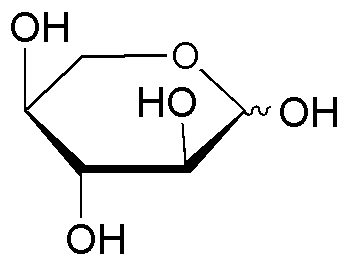L-(-)-Xylose is widely utilized in research focused on:
- Food Industry: Used as a low-calorie sweetener and sugar substitute, L-(-)-Xylose is beneficial for formulating products aimed at diabetic consumers.
- Pharmaceuticals: It serves as a key ingredient in drug formulations, enhancing the bioavailability of certain medications by improving solubility.
- Biotechnology: In microbiology, it is employed as a carbon source for culturing specific bacteria, aiding in the production of enzymes and other bioproducts.
- Research Applications: Commonly used in studies related to carbohydrate metabolism, it helps researchers understand metabolic pathways and their implications in health and disease.
- Cosmetics: L-(-)-Xylose is incorporated into skincare products for its moisturizing properties, offering a natural alternative to synthetic humectants.
General Information
Properties
Safety and Regulations
Applications
L-(-)-Xylose is widely utilized in research focused on:
- Food Industry: Used as a low-calorie sweetener and sugar substitute, L-(-)-Xylose is beneficial for formulating products aimed at diabetic consumers.
- Pharmaceuticals: It serves as a key ingredient in drug formulations, enhancing the bioavailability of certain medications by improving solubility.
- Biotechnology: In microbiology, it is employed as a carbon source for culturing specific bacteria, aiding in the production of enzymes and other bioproducts.
- Research Applications: Commonly used in studies related to carbohydrate metabolism, it helps researchers understand metabolic pathways and their implications in health and disease.
- Cosmetics: L-(-)-Xylose is incorporated into skincare products for its moisturizing properties, offering a natural alternative to synthetic humectants.
Documents
Safety Data Sheets (SDS)
The SDS provides comprehensive safety information on handling, storage, and disposal of the product.
Product Specification (PS)
The PS provides a comprehensive breakdown of the product’s properties, including chemical composition, physical state, purity, and storage requirements. It also details acceptable quality ranges and the product's intended applications.
Certificates of Analysis (COA)
Search for Certificates of Analysis (COA) by entering the products Lot Number. Lot and Batch Numbers can be found on a product’s label following the words ‘Lot’ or ‘Batch’.
Numéro de catalogue
Numéro de lot/série
Certificates Of Origin (COO)
This COO confirms the country where the product was manufactured, and also details the materials and components used in it and whether it is derived from natural, synthetic, or other specific sources. This certificate may be required for customs, trade, and regulatory compliance.
Numéro de catalogue
Numéro de lot/série
Safety Data Sheets (SDS)
The SDS provides comprehensive safety information on handling, storage, and disposal of the product.
DownloadProduct Specification (PS)
The PS provides a comprehensive breakdown of the product’s properties, including chemical composition, physical state, purity, and storage requirements. It also details acceptable quality ranges and the product's intended applications.
DownloadCertificates of Analysis (COA)
Search for Certificates of Analysis (COA) by entering the products Lot Number. Lot and Batch Numbers can be found on a product’s label following the words ‘Lot’ or ‘Batch’.
Numéro de catalogue
Numéro de lot/série
Certificates Of Origin (COO)
This COO confirms the country where the product was manufactured, and also details the materials and components used in it and whether it is derived from natural, synthetic, or other specific sources. This certificate may be required for customs, trade, and regulatory compliance.


